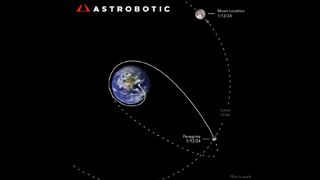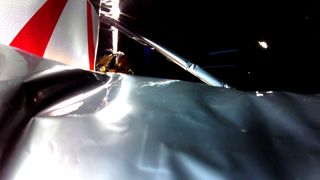
Astrobotic's Peregrine lander has made it out to lunar distance, a major milestone for the crippled craft — but a moon landing still doesn't appear to be in the cards.
Peregrine launched Jan. 8 on the first-ever liftoff of United Launch Alliance's Vulcan Centaur rocket. The spacecraft aimed to make history, becoming the first private lander ever to ace a soft touchdown on the moon.
Peregrine suffered a serious propellant leak shortly after separating from the rocket's upper stage, apparently scuttling that dream. But the lander lives yet, cruising through deep space — and, just now, making it all the way out to the moon's neighborhood.
"Peregrine remains operational at about 238,000 miles [383,000 kilometers] from Earth, which means that we have reached lunar distance!" Astrobotic wrote in a post on X on Friday afternoon (Jan. 12).
But the moon is in a different part of its orbit at the moment, far from the lander, the Pittsburgh-based company stressed.
"Our original trajectory had us landing on the moon on day 15 post-launch," Astrobotic wrote in Friday's update. "Our propellant estimates currently have us running out of fuel before this 15-day mark — however, our engineers are still optimistic about extending Peregrine's life expectancy."
Related: Private Peregrine moon lander failure won't stop NASA's ambitious commercial lunar program
Get the Space.com Newsletter
Breaking space news, the latest updates on rocket launches, skywatching events and more!

That optimism is borne of experience. Just after Peregrine sprang its leak, the mission team estimated that the lander had just 40 hours' worth of propellant left. But that timeline keeps shifting to the right, as Peregrine's leak continues to slow and its handlers work to squeeze as much life out of the spacecraft as possible.
Peregrine is carrying 20 payloads for a variety of customers, including NASA, which put five science instruments on board via its Commercial Lunar Payloads Services (CLPS) program.
All 10 of the payloads that require power are getting it, Astrobotic said in a previous update. (The other 10 payloads are passive.) And some of these instruments are gathering useful data in deep space, though they likely will never reach the lunar surface as intended.
For example, two of the NASA payloads, the Neutron Spectrometer System and the Linear Energy Transfer Spectrometer, "are making measurements of the radiation environment in interplanetary space around the Earth and the moon," agency officials wrote in an update on Thursday (Jan. 11).
"The two instruments are measuring different components of the radiation spectrum, which provide complementary insights into the galactic cosmic ray activity and space weather resulting from solar activity," they added. "This data helps characterize the interplanetary radiation environment for humans and electronics."
Astrobotic also reported that Peregrine's COLMENA payload, which includes five tiny micro-robots built to explore the lunar surface by the National Autonomous University of Mexico, was successfully powered up on Friday, making it "the first Mexican instrument to operate in cis-lunar space," Astrobotic wrote. A video from the university shows mission team members applauding as they received confirmation of COLMENA's activation, even though its not expected to land on the moon.
(2/2) Update #13: Payload teams continue to operate & receive power & telemetry. Below is a video from the moment the COLMENA payload team began receiving data confirming it is now the first Mexican instrument to operate in cislunar space. (Video credit: UNAM) pic.twitter.com/GLiZtZY6NIJanuary 12, 2024
Astrobotic has been keeping us posted about Peregrine's situation assiduously; Friday's update was the 15th it has published since the lander experienced its problem on Jan. 8.
And we'll get a more detailed appraisal next week: Astrobotic and NASA will hold a teleconference at noon EST (1700 GMT) on Jan. 18 to discuss Peregrine's plight.
Peregrine was the first in a series of CLPS-affiliated missions to launch with payloads bound for the moon. The next liftoff is scheduled to come next month, when a SpaceX Falcon 9 rocket lofts the Nova-C lander, built by Houston company Intuitive Machines.
Join our Space Forums to keep talking space on the latest missions, night sky and more! And if you have a news tip, correction or comment, let us know at: community@space.com.

Michael Wall is a Senior Space Writer with Space.com and joined the team in 2010. He primarily covers exoplanets, spaceflight and military space, but has been known to dabble in the space art beat. His book about the search for alien life, "Out There," was published on Nov. 13, 2018. Before becoming a science writer, Michael worked as a herpetologist and wildlife biologist. He has a Ph.D. in evolutionary biology from the University of Sydney, Australia, a bachelor's degree from the University of Arizona, and a graduate certificate in science writing from the University of California, Santa Cruz. To find out what his latest project is, you can follow Michael on Twitter.
